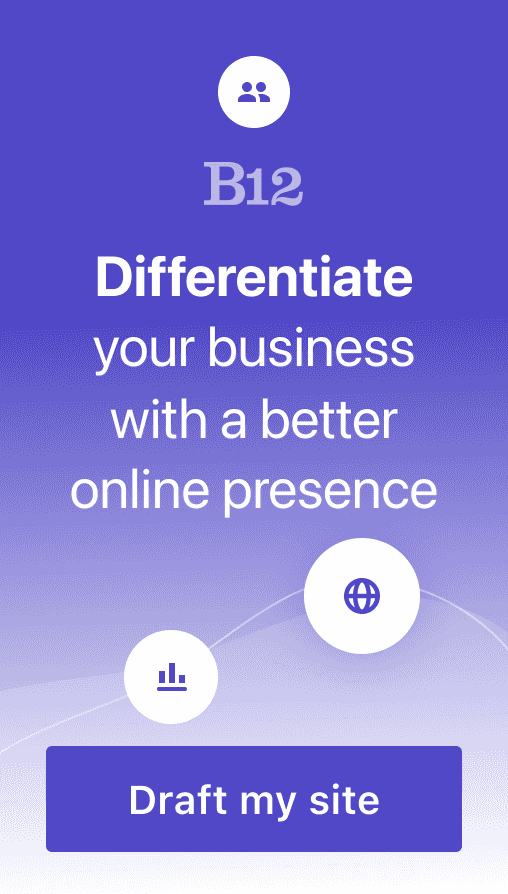Build an AI website in 60 seconds
AI generates your personalized website instantly with built-in scheduling, payments, email marketing, and more.
Start for free
Differences in selling products vs. services

When running a business, understanding the differences between selling products and selling services is crucial. While both contribute to the success and growth of a company, they possess distinct characteristics that require different marketing strategies and considerations.
In this blog post, we will explore the definitions of products and services and delve into the disparities between the two. By understanding these discrepancies, businesses can better tailor their marketing efforts and capitalize on the unique advantages offered by each.
What are products and services?
Defining goods and services
Products refer to tangible items that can be seen, touched, and measured. They are physical entities that consumers can purchase, own, and utilize. Examples of products include cars, clothing, electronics, and furniture. On the other hand, services are intangible offerings that provide intangible value to customers. They are actions, performances, or efforts to satisfy a consumer's needs. Services may include professional consultations, haircuts, healthcare, or legal advice.
Understanding the differences between products and services
While products and services cater to consumers' desires, they differ significantly in tangibility, durability, and transferability. Products are often created, stored, and transported before being sold to the customer, allowing for physical examination and evaluation. Conversely, services are often consumed immediately, involving direct interaction between the provider and the consumer. Understanding these fundamental divergences is crucial for businesses when designing marketing strategies and determining how to meet customer demands best.
Examples of goods and services in various industries
Goods and services are present in almost every industry, and understanding the distinction between the two is crucial for businesses. Retail goods such as clothing, electronics, and household items are sold to consumers. Medical consultations, surgical procedures, and diagnostic tests are provided to patients in the healthcare industry. In the hospitality industry, goods like food and beverages are consumed by customers, while services such as accommodation, housekeeping, and entertainment are offered.
Another example is the automotive industry, where goods like cars, motorcycles, and spare parts are manufactured and sold, and services like vehicle repairs, maintenance, and insurance are provided. In the banking industry, goods like credit cards, loans, and investment products are offered to customers, while services such as account management, financial advice, and transaction processing are provided. These diverse examples illustrate the wide range of goods and services across different economic sectors.
By grasping the distinctions between goods and services and recognizing their examples across various industries, businesses can better understand the unique characteristics and requirements of selling a product or a service. This knowledge lays the foundation for effective marketing strategies and decision-making in the competitive marketplace.
Tangibility and physical attributes
Products are tangible and have physical attributes that can be seen, touched, and experienced. They are typically real goods that can be manufactured, packaged, and shipped. For example, a smartphone, a pair of shoes, or a car are all physical products that can be held in your hands. Tangible products provide customers with a concrete representation of what they are purchasing, making evaluating and comparing different options easier.
Perishability and durability
One key characteristic of products is that they can be perishable or have a limited lifespan. Some products, such as fresh produce or perishable food items, have a short shelf life and can spoil or become unusable if not consumed or used within a certain timeframe. On the other hand, durable goods like appliances or furniture are designed to last for an extended period. Understanding the perishability or durability of a product is crucial for businesses when it comes to managing inventory, pricing, and ensuring customer satisfaction.
Intangibility and inseparability
Unlike products, services are intangible and cannot be held or experienced in the same way as physical goods. Benefits are based on actions, performances, or efforts individuals or organizations provide to fulfill specific customer needs or wants. Examples of services include haircuts, consulting, or healthcare. The intangibility of services poses challenges for businesses regarding marketing and communication.
Since benefits cannot be physically observed or tested before purchase, companies must rely heavily on branding, reputation, and testimonials to convey the value of their services to potential customers. Additionally, services are often inseparable from the service provider, requiring direct interaction or participation between the provider and the consumer.
When it comes to services, one of the key characteristics is intangibility. Unlike products, benefits cannot be seen or touched. Instead, they are experienced or consumed. For example, when you visit a salon for a haircut, you are paying for the service of getting your hair styled rather than a tangible product. This intangible nature of services makes it challenging for businesses to showcase and demonstrate their value to potential customers.
Furthermore, services are often inseparable from the individual or organization providing them. This means that the person providing the service is an integral part of the overall experience. For instance, a fitness trainer's expertise and guidance are essential in delivering quality fitness training services. This close connection between the service provider and the service itself adds another layer of complexity in maintaining consistency and quality.
By understanding these characteristics of services, businesses can better tailor their marketing strategies and manage customer expectations to ensure a positive and consistent experience.
Selling products vs. selling services
Marketing strategies for products
When selling products, businesses often rely on traditional marketing strategies to showcase their tangible offerings. They emphasize features, benefits, and unique selling points to attract customers. Product demonstrations, packaging design, and price promotions play a significant role in driving sales. Additionally, businesses can utilize various distribution channels, such as retail stores, e-commerce platforms, and wholesale partnerships, to reach a wider customer base. Comprehensive market research and competitor analysis are essential to develop effective positioning and branding strategies that differentiate products from similar offerings in the market.
Marketing strategies for services
Selling services requires a different approach due to their intangible nature. Service businesses focus on creating a strong brand identity and reputation, as trust and credibility are crucial factors in attracting customers. Storytelling through customer testimonials and case studies can effectively showcase the value and results that the service can deliver. Service providers often utilize digital marketing techniques like search engine optimization and content marketing to build an online presence and generate leads. In addition, networking, referrals, and partnerships with complementary businesses can help service providers expand their customer base and gain trust in the industry.
Challenges and considerations in selling products and services
Both selling products and services come with their own set of challenges. For product-based businesses, maintaining inventory levels and managing supply chains can be complex and requires efficient logistics management. On the other hand, service providers must carefully manage their capacity and resources to meet customer demands without compromising quality.
While selling products may involve a one-time transaction, services often entail ongoing customer relationships, requiring strong customer service and support. Furthermore, pricing can be a greater challenge for assistance as their value is more subjective and difficult to quantify than tangible products. When developing their marketing strategies, businesses must also consider factors like competition, market trends, and consumer preferences.
Understanding the differences between selling products and services is crucial for businesses to develop effective marketing strategies. While products focus on tangible features and benefits, services emphasize intangible value and customer relationships. Companies can effectively engage, attract, and retain customers by tailoring their marketing efforts to the unique characteristics of their offerings. By recognizing the challenges and considerations associated with each, businesses can navigate the selling process more successfully and make informed decisions that lead to growth and profitability.
Importance of understanding the distinction for businesses
Understanding the distinction between selling products and services is crucial for businesses. It impacts their marketing strategies, customer experience, and pricing. By recognizing the unique characteristics of their offerings and tailoring their approach accordingly, companies can effectively communicate the value of their products or services to customers, leading to greater success and customer satisfaction.
Adapting marketing strategies for products and services
Regarding marketing, businesses must adapt their strategies based on whether they sell products or services. For products, marketing efforts may highlight tangible features, demonstrate functionality, and emphasize durability or long-term value. On the other hand, services require a different approach, focusing on building trust, showcasing expertise, and highlighting the intangible benefits customers can expect.
Challenges and considerations in selling products and services
Selling products and services also presents unique challenges and considerations for businesses. Pricing can be more straightforward with consequences, as they often have a tangible production cost. However, pricing services can be more complex as factors such as time, expertise, and market demand come into play. Additionally, services are often more subjective in quality, making it important for businesses to consistently provide exceptional experiences and address variations in service delivery. Finally, companies selling both products and services may need to balance their marketing efforts and resources to promote both offerings effectively.
Build your service business’ online presence with B12’s AI website builder
B12's website builder is an all-in-one platform for professional services.
Attract leads, win business, and serve clients online with a professional site, scheduling, payments, intake, and more. Build your free site today.
B12 can quickly build an entire website using artificial intelligence technology. Answer a few questions about your company, and generative AI will create a website draft with images and copy tailored to your sector. With the B12 Editor, you can start with your website draft and make changes in real-time.
Furthermore, B12 websites also offer various third-party integrations that make your website stand out from the rest. You can check the list of all integrations here.
Attract, win, and serve more clients
Receive helpful resources directly to your inbox to help you succeed online.
Draft your site in 60 seconds
Get an AI website made specifically for you that's free to launch.
Start for free ✨No credit card required
Related posts
Spend less time on your website and more time growing your business
Let B12 set up your professional online presence with everything you need to attract, win, and serve clients.





